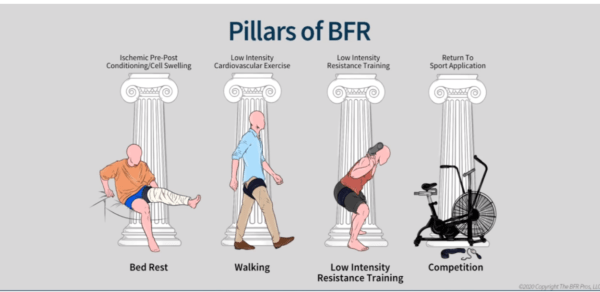Think Passive BFR Is Boring? Think Again! (part 2)
If you haven’t checked out Part 1 yet, go ahead and check it out! Welcome to Part 2. Before we dive in, let’s quickly take a look at the Pillars of blood flow restriction training. In Part 1, we spoke about how isometrics can be a great way to progress passive BFR. Today we’re talking about how neuromuscular electrical stimulation (NMES) can be used to enhance the effect of Pillar 1.
As mentioned in Part 1, Pillar 1 is fleeting. We want to spend as little time in Pillar 1 as possible, then get the heck out of there. There are two main goals of Pillar 1: muscle preservation and acclimation to BFR to prepare for Pillars 2-4. Pillar 1 works through cell swelling, which is the process by which muscle cells experience a rapid influx of fluid due to the build up of metabolites associated with BFR training. A typical cell swelling protocol is as follows:
NMES has been shown to be a safe and effective way to enhance muscular adaptation, however a barrier to its use is the high levels of stimulation intensity required and therefore, high levels of patient discomfort. Using the maximum tolerable intensity with NMES may sound intriguing for some of us masochists out there, but it is FOR SURE a deterrent for many other folks. We know that BFR allows us to exercise at lower intensities while still reaping the benefits of higher intensities, so what if BFR could do the same for NMES? What if we could use a lesser stimulation intensity and still reap similar benefits as a maximum tolerable intensity? That’s the exact question researchers are asking.
As with isometrics, the goal is not necessarily to build muscle, but rather to reduce muscle breakdown and help with acclimation to metabolite discomfort. So, what does the summation of the research say is the optimal NMES/BFR protocol? Well…we uh…actually uhh…we don’t know. That’s right! The research on the subject is quite inconsistent (Head, 2020). We see studies using a range of intensities from 12% all the way to 95% of max tolerable level (Gondin et al, 2005) (Jubeau et al, 2008). We also see variations in electrode placement and occlusion pressure (Head, 2020).
Despite the inconsistencies in the literature, it seems like combining BFR with NMES may have positive effects on muscle loss (Slysz, 2020), strength (Natsume, 2015) (Slysz, 2017), and hypertrophy (Natsume, 2015) (Natsume, 2018). There are even studies assessing the impact of BFR and NMES on spinal cord injury (Gorgey, 2016) and pediatric congenital spinal instability (Iwashita, 2015)! You’re best bet is to use the minimal effective cuff pressure with either a low, medium, or high intensity stimulation at least 2x/day 5x/week, as multiple sessions per day seems to out perform single daily sessions.
Don’t forget about muscle length considerations! Position the muscle in a fully lengthened position and you can expect increased tension AND increased patient discomfort. Position the muscle in a shortened position and you can expect less tension, but a more tolerable experience for the patient. Use that information as you see fit and explore progressions and regressions depending on the individual in front of you. Go get em!
References:
Gondin J, Guette M, Ballay Y, Martin A. (2005) Electromyostimulation training effects on neural drive and muscle architecture. Med Sci Sports Exerc; 37(8):1291–9.
Gorgey, A. S., Timmons, M. K., Dolbow, D. R., Bengel, J., Fugate-Laus, K. C., Michener, L. A., & Gater, D. R. (2016). Electrical stimulation and blood flow restriction increase wrist extensor cross-sectional area and flow meditated dilatation following spinal cord injury. European journal of applied physiology, 116(6), 1231–1244. https://doi.org/10.1007/s00421-016-3385-z
Head, P., Waldron, M., Theis, N., & Patterson, S. D. (2020). Acute Neuromuscular Electrical Stimulation (NMES) With Blood Flow Restriction: The Effect of Restriction Pressures. Journal of sport rehabilitation, 30(3), 375–383. https://doi.org/10.1123/jsr.2019-0505
Iwashita, H. (2015). A pediatric case with an unstabilized neck treated with skeletal muscle electrical stimulation and KAATSU training®. International Journal of KAATSU Training Research. 11. 7-12. 10.3806/ijktr.11.7
Jubeau M, Sartorio A, Marinone PG, et al. (1985). Comparison between voluntary and stimulated contractions of the quadriceps femoris for growth hormone response and muscle damage. J Appl Physiol. 2008;104(1):75–81.
Natsume, T., Ozaki, H., Saito, A. I., Abe, T., & Naito, H. (2015). Effects of Electrostimulation with Blood Flow Restriction on Muscle Size and Strength. Medicine and science in sports and exercise, 47(12), 2621–2627. https://doi.org/10.1249/MSS.0000000000000722
Natsume, T., Yoshihara, T., & Naito, H. (2019). Electromyostimulation with blood flow restriction enhances activation of mTOR and MAPK signaling pathways in rat gastrocnemius muscles. Applied physiology, nutrition, and metabolism = Physiologie appliquee, nutrition et metabolisme, 44(6), 637–644. https://doi.org/10.1139/apnm-2018-0384
Slysz, J. T., & Burr, J. F. (2018). The Effects of Blood Flow Restricted Electrostimulation on Strength and Hypertrophy. Journal of sport rehabilitation, 27(3), 257–262. https://doi.org/10.1123/jsr.2017-0002
Slysz, J. T., Boston, M., King, R., Pignanelli, C., Power, G. A., & Burr, J. F. (2021). Blood Flow Restriction Combined with Electrical Stimulation Attenuates Thigh Muscle Disuse Atrophy. Medicine and science in sports and exercise, 53(5), 1033–1040. https://doi.org/10.1249/MSS.0000000000002544
****Remember, the decision to use BFR, or any treatment for that matter, should be based on the pillars of evidence-based practice.
Are you ready to meet the growing demand as a Confident BFR Provider?
Be sure to check out our engaging 4-hour On Demand On-Line BFR Training course at www.BFRtraining.com
Our course is for both Rehab and Fitness professionals and will provide everything you will need to overcome the three hurdles for successful BFR Training and help guide you to become a Confident Successful BFR Provider.
Use this LINK for $75 off the original price! Or use coupon code BFR75 at checkout.


